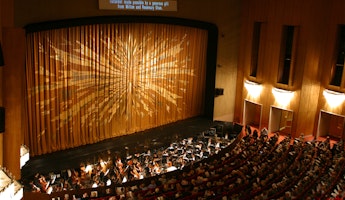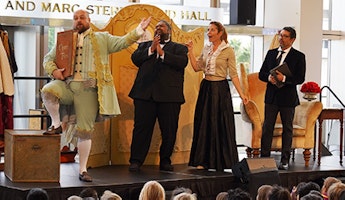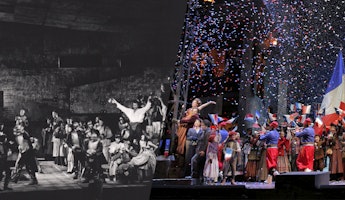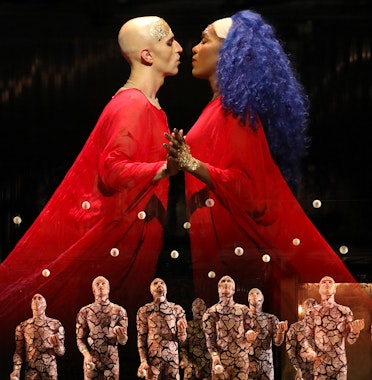Blog
March 8, 2023
Destiny: A Note from Music Director James Conlon
"The fault, dear Brutus, is not in our stars / But in ourselves"
—William Shakespeare (Julius Caesar, Act I, sc. III)
"Many a happiness in life, and many a disaster, is due to chance alone; but the peace within us is never governed by chance.”
—Maurice Maeterlinck
Though they had remarkably little personal contact, weren’t friends and were barely collaborators, Destiny would unite in perpetuity the names of French composer Claude Debussy and Belgian dramatist Maurice Maeterlinck. They were born seven days apart, Debussy, the elder, near Paris on August 22, 1862, and Maeterlinck in Ghent. The latter, a writer symbolist poet and Nobel Prize winner, wrote a five-act play entitled Pelléas et Mélisande, published in 1892. Claude Debussy saw in it a perfect vehicle for an opera suited to his principles and preferences, and set most of its text to his own very personal music. The music was not to serve a form; rather, the form was to flow from the music, and they were both to issue from the drama and the word. Debussy's creation was an absolute masterpiece, one that opened a new path to many other composers, often imitated, but never equaled.
Debussy's goal was to create an opera according to his own sensibilities, without regard to—in fact, in spite of—all the rules, forms and conventions that dominated the preceding two centuries. Despite Debussy's rejection of Richard Wagner (after having been thoroughly bathed in Wagnerian waters in his youth), that Teutonic master's shadow remained long and inescapable. The parallels and inspiration of Tristan and Isolde and Parsifal are manifest. And yet Pelléas in unmistakably pure Debussy, from the first to the last note.
The French composer rejected most established forms. He never composed a symphony, considering the model as depleted. He wrote no solo concertos, wrote only one string quartet, and no "traditional" sacred music. Only at the end of his life, at the urging of his publisher Jacques Durand, did he write three sonatas (for cello and piano; flute, viola and harp; and violin and piano).
His determination to create music as "form" out of "substance" (not vice versa) led him to choose a work that gave him the required space for his muse. Writing about Maeterlinck's play, he explains why: "The drama of Pelléas... which, despite its atmosphere of dreams, contains much more humanity than so-called real-life documents, seemed to suit my intention admirably. It has an evocative language whose sensitivity could find its extension in music and orchestral setting."
He reveals much in that statement. And much of it reflects Wagnerian principles.
First, he would not employ a librettist (Wagner, of course, wrote his own poetry) or tailor a text for an operatic vehicle. His decision to set an existing prose play, word for word (with only minor cuts), was an exceptional step that inspired considerable polemics at the time. But this precedent was followed quickly by Richard Strauss (Oscar Wilde's Salome), Alexander Zemlinsky (Wilde's A Florentine Tragedy) and Alban Berg (Georg Büchner's Woyzeck).
Secondly, he tacitly reveals the orchestra as the universe that carries and embodies the musical and dramatic substance of the essence of Pelléas. In its omniscience, the orchestra "knows" and understands things unknown to the characters themselves. In its omnipresence, it envelops the listener with its aura and powerful force. In other words, Debussy's orchestra does everything that Wagner's had done before him. Debussy employs certain Leitmotivs (leading motives) associated with the protagonists (even though he had recently ridiculed Wagner's practice of doing so), which travel through the orchestral fabric for the entire length of the opera.
He fully adopts Wagner's "through-composed" musical style: no stops, no closed forms, no places for applause to interrupt the dramatic and musical flow. Another Wagnerian principle (although the master of Bayreuth regularly ignored his own injunction): only one character sings at a time. (There is a fleeting exception when the lovers finally unite to attempt to consummate their attraction.) When a scene is shared by more than one person, there is either a conversation or an alternation of voices, but never a duet or trio or anything resembling old forms. There are no arias. The conventional aria existed either as a showcase for beautiful singing (bel canto), which Debussy vehemently opposed, or as a confessional, in which a character tells his or her story. But how could there be an aria in an opera when almost no one, most of all Mélisande, reveals what he or she is thinking? There is no chorus except for one "pictorial" effect, an unseen group of mariners singing offstage, a moment repeated several years later by Giacomo Puccini in Madama Butterfly.
As the singers are meant to clearly enunciate their French texts, they mostly sing in their middle and lower registers, which most resembles that of normal speech. The singers are only required to sing in their upper registers at moments of intense emotions reflecting excitement, passion or anger.
Debussy creates a musical sound world based on the French language, just as Mussorgsky had done for Russian and Janáček would later do for Czech. Like his Russian counterpart, he adopts the arioso style (particularly evident in Arkel's music) as an excellent conduit for lyrical expression that does not require florid singing but respects the spoken language and yet has horizontal beauty provided by the orchestra. Debussy seemed to have had a particular dislike for holding any note longer than its natural spoken length Through its predominant recitative, Pelléas hearkens back to Monteverdi, Rameau and Lully.
We find ourselves in a world of contradictions: multiple sources, mysterious forces, apparent autonomy negated by unseen powers, a world of pseudo-mythology contrasted with the traditional operatic love-jealousy-murder triangle, a music at the same time simple and complex, the word dominating the music, an opera that denies vocalism, an orchestra that remains a transparent vehicle for the text and yet is the purveyor of the musical content and the fullest expression of Maeterlinck's universe, a musical structure that is simultaneously highly rational, organized, lucid, passionate and beautiful yet seemingly rhapsodic and formless. A symbolist text that drifts between a world divided by outward form and "ideas" and a musical text that rejects any suggestion of conventional formal structures (operatic, symphonic, lyric periodicity, harmonic) in favor of an immense juxtaposition of cellular moments, a perspective in which the unifying force and form is arrived at through an infinitesimal number of particulars.
These are the dialectic elements of Pelléas et Mélisande that, left in the hands of anyone less than one of the great creative geniuses of western classical music, would have resulted in amorphous, meaningless nonsense. Instead, in what must be considered one of the most felicitous encounters between a literary movement and an embryonic revolution in music, a dramatic work found its fullest expression in the form of music, and a musician found the ideal text with which to give precision and direction to his highly refined music.
The mysteries of Pelléas are not explained. It is a work that by its very nature suggests but does not reveal, asking questions but not answering. Although Symbolism, the literary basis of the work, was an idea that had more or less run its course during the composer's lifetime, Debussy immortalized it beyond its historical limits, distilling the best ideas from the Symbolists and forging a transcendent work and a way forward.
Imagine if Debussy had, as did Wagner, built his own Bayreuth around Pelléas. The performance history of this work might have been very different. It is up to those of us who believe in this particular "Holy Grail" to create and recreate its magic constantly, in noisy cities, in cacophonous operatic marketplaces, squeezed in between repertory performances of Pagliacci, The Merry Widow and La Bohème.
Debussy received international recognition after the premiere of Pelléas. The work was recognized immediately for its genius by some. It was exported quickly but did not necessarily take root in opera houses dominated by the Italian or German tradition. In addition, by the composer's express intent, there were no vocal acrobatics, no noisy cabalettas, bombastic overtures or choruses, no crashing cymbals or blaring brass and, most of all, no required (in France) ballet. There were none of these conventional props to excite an audience long accustomed to that brand of stimulation.
The demands on the listening public are in some ways more suited to the concert-going audience than the operatic public. The distance is minimal between the aesthetic of Pelléas and, for instance, those of The Afternoon of a Faun, Au Claire de Lune, La Mer or the Piano Préludes. It is much closer to any of those pieces than to Don Pasquale, Il Trovatore or even Carmen.
There are no arias that could be excerpted and popularized. How could there be in a work where no character is ever alone on the stage? Self-revelation is the dynamic of the solo operatic aria, and the characters in Pelléas, especially Melisande, do everything but reveal themselves.
The typical operatic diva or divo has little interest in a work that does not show off the voice, in which there is no interruption for applause to fondle the operatic ego, and whose final act is quiet, sad and intimate— almost guaranteeing that a sensitive execution of the work will discourage noisy and prolonged applause. All of this was hardly attractive for less serious "success-seeking" singers and conductors. But for those who live under the spell of Debussy's magic, these considerations do not even present themselves. For them, Pelléas must be a labor of love. It requires the orchestra and conductor to devote sustained concentration to detail, clarity, tone color, transparency and expression. The balance of tempi and orchestral color needs to elucidate and clarify the text without sacrificing passion and dramatic intensity.
The capacity to sustain quiet slow music over large expanses is required. This must be accomplished through a sustained musical narrative in an expanded time frame by executing (in its quick, quintessentially French manner) numerous and successive gradations of dynamics, rhythm and color within short spaces, one bar at a time, over extended scenes.
Pelléas belongs to a group of works that should be constantly performed, studied and revisited. Like Parsifal, Tristan und Isolde, Boris Godunov and Wozzeck, Pelléas is unique and does not belong to any tradition or genre. It towers over every other work in the French repertory, with the possible exception of Carmen. It is as specifically French as Mussorgsky's Boris Godunov is Russian, it is nevertheless not a nationalistic work but a universal one. It has left an indelible mark on 20th-century music, parallel to what the Préludes did for the piano, or The Afternoon of a Faun and La Mer for orchestra music.
The greatest influence on Debussy was Wagner, and his subsequent rebellion against him was vehement. But without the German master (and Mussorgsky), we would not have the Debussy we know. Debussy revived the fundamentals of the Florentine Camerata and Monteverdi, and without dogmatism, found his own balance between word and music, anticipating Strauss’s famous polemic "Prima le parole, poi la musica" (“first the word, then the music,” a topic he argued in his opera Capriccio).
Without those theoretical and practical examples, would Debussy have had the models to create for French opera what Mussorgsky had for Russian opera, the belief that the natural cadence of the spoken language would serve as a basis for the musical language? This thought produced two completely different works in those languages. But the musical parallels are too striking and numerous to leave doubt that Mussorgsky's more endearing presence remained as much in Debussy's mind as did Wagner's sometimes ominous shadow
The world view of Pelléas has much in common with another work that may have influenced Mussorgsky: Verdi's most nihilistic work and only true epic drama, La Forza del Destino, which premiered during Mussorgsky's formative years in St. Petersburg in 1862. The young Russian rejected its Italian origin but some of its lessons were not lost on him. It is fascinating to meditate on these composers and their works. It is hard to imagine more different musical works composed with a similar world view.
The common theme is Destiny, clearly differently treated first by Wagner and Verdi, then by Mussorgsky and Debussy. Tristan's Destiny comes from unavoidable, uncontrollable inner drives. Mussorgsky's dominating force and destiny is to be found in "History" (writ large): massive, all-embracing, awesome, inevitable. The composer means Russian History, but the work is universal and transcends its national character. Verdi's Destiny is the dominating force; human agency is secondary. Don Alvaro will be eternally unhappy: "e scritto" (it is written).
The Destiny of Debussy and Maeterlinck is not to be found in ourselves but in our stars, contradicting Shakespeare's admonition in Julius Caesar. It resides in mysterious forces greater than human events and history. Wagner's Ring characters are mythic, Verdi's are fictional but real, Boris Godunov's are concretely historical and those in Pélleas are pseudo-mythic, real people in an unreal time and place. Together they constitute a small community illustrating the human struggle with the problem of mystery, the power of fate and free will.
This mystery is embodied in Mélisande, of whom we understand nothing more at the end of the opera than we did at the beginning. She silently slips away. ("Elle s'en va sans rien dire.") She leaves the world and her existence in a dark medieval castle, situated in an imaginary unidentified kingdom, with a complicated, unexplained and inexplicable family of royals.
The quiet contemplation of this mysterious work, conceived far from the Babelian chatter of modern life, seems an inviting haven to meditate on our own time, and what civilization and society have wrought, gained and lost. Its power is not yet exhausted by any means. Debussy worked ten years on its creation, but like the great cathedrals of Europe, it may take centuries for it to be fully understood and completed.








/03-cosi/_dsc0996_pr.jpg?format=auto&fit=crop&w=345&h=200&auto=format)
















